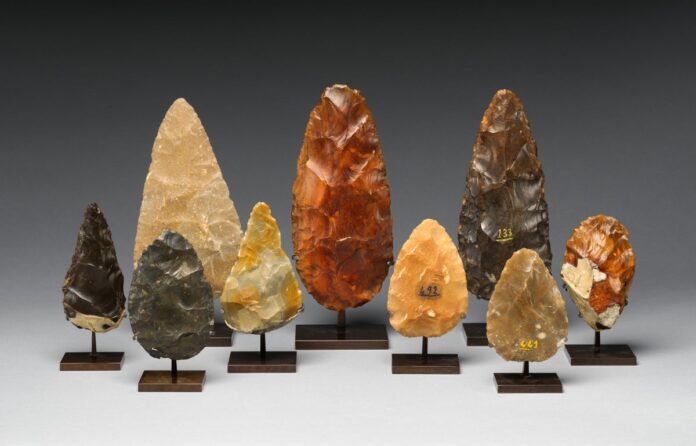We humans are nothing if not inventive. Our innovations have come to underpin virtually every facet of daily life—from what we eat to how we communicate. This ingenuity is intrinsically linked to both our outsize brain and our hands, which are remarkably dexterous compared with those of other primates. Paleoanthropologists have long sought the origins of human technological innovation. The famous Lucy fossil, discovered 50 years ago this month, ushered in a new understanding of this hallmark of humankind.
In the 1950s English paleoanthropologist Kenneth Oakley emphasized toolmaking as a unique human trait because unlike, say, language, it could be demonstrated by archaeological evidence. Tool use and, particularly, toolmaking were considered distinctly human abilities that, according to Oakley, most likely started with the large-brained ancestor Pithecanthropus erectus, now known as Homo erectus.
In the 1960s, after years of trailblazing primatological research in the Tanzanian rainforest, Jane Goodall showed the world that chimpanzees in what is now Gombe Stream National Park in Tanzania regularly used sticks to fish for termites and ants and also used leaves as tools to drink water. Although Charles Darwin had noted nearly 100 years earlier that “the chimpanzee in a state of nature cracks a native fruit, somewhat like a walnut, with a stone,” it was Goodall who first thoroughly documented chimpanzees modifying organic tools and using them to gain access to otherwise inaccessible resources. This revelation led Kenyan paleoanthropologist Louis Leakey to famously state, “Now we must redefine tool, redefine man or accept chimpanzees as humans.”
On supporting science journalism
If you’re enjoying this article, consider supporting our award-winning journalism by subscribing. By purchasing a subscription you are helping to ensure the future of impactful stories about the discoveries and ideas shaping our world today.
Still, the notion that humans were the only true toolmakers held on for a bit longer, with proponents arguing that only humans and their ancestors in the genus Homo used tools regularly and with a high order of skill. Indeed, around the same time that Goodall announced her findings, Leakey and his colleagues defined a new species of fossil human—Homo habilis, meaning “handy human” or “able human”—at Oldupai (formerly Olduvai) Gorge in Tanzania based on the creature’s presumed ability to make tools from stone, as opposed to the organic tools made by chimpanzees. Louis and Mary Leakey had found the new fossils in association with stone tools, and the cranial bones indicated a larger brain than more ancient hominins (members of the human family). What is more, several hand bones were interpreted as reflecting the necessary dexterity to make stone tools. Because stone toolmaking was distinctive to humans, Leakey insisted these new fossils must be belong to a member of our genus, Homo.
The discoveries at Oldupai dominated scientists’ understanding of the early hominin hand and tool behaviors for decades. When the partial skeleton of the 3.2-million-year-old human ancestor known as Lucy was discovered in November 1974, no one initially considered whether she might have made or used stone tools. This may have been in part because Lucy’s skeleton only preserved two hand bones—a bone at the center of the wrist, called the capitate, and a finger bone called a proximal phalanx. But even the discovery of a trove of fossils of Lucy’s species at the nearby site A.L. 333 the following year—a find that included numerous hand bones—did not elicit discussion about tool behaviors in Australopithecus afarensis, Lucy’s species. Not only was stone tool technology still considered unique to Homo, but also, at an age of 3.2 million years, Lucy was 1.5 million years older than the earliest stone tools known at the time.
In 1983 the late anthropologist Mary Marzke was the first to offer a functional interpretation of the morphology of Lucy’s hand bones and those found at the A.L. 333 site. Her pioneering work highlighted a mix of humanlike features, such as a relatively long thumb and short fingers, and apelike features, such as limited mobility of the little finger and curved finger bones. Marzke inferred from the hand bone morphology the types of grips that Lucy and her kind may have used, such as pad-to-side grips, which we utilize when we turn a key in a lock, and three-digit grips, which we employ when we throw a baseball. Marzke suggested that, using these grips, A. afarensis could manipulate stone tools to hammer animal bones to extract the nutrient-rich marrow inside and to cut meat with stone flakes. But despite Marzke’s interpretation, scientists generally clung to the idea that stone tool behaviors only arose with the genus Homo.
Marzke was well ahead of her time. We would have to wait nearly 20 years for the archaeological evidence of the behaviors she inferred from the hand morphology of A. afarensis. In 2010 researchers found evidence of hammering (or percussion) and cut marks on animal bones at the A. afarensis site of Dikika in Ethiopia, dated to 3.4 million years ago. Five years later another team unveiled large and crude stone tools representing a previously unknown technology from the site of Lomekwi in Kenya, dated to 3.3 million years ago. These finds offered the first evidence of stone tool manufacture during the time of A. afarensis.
The idea that Lucy could use and most likely make stone tools is further supported by all we have learned about nonhuman primate tool use since her discovery. In the early 1980s, building on Goodall’s work, two primatologists, Hedwige Boesch-Achermann and the late Christophe Boesch, documented chimpanzees cracking nuts with stone and wooden hammers in Taï National Park in Ivory Coast. We now know from archaeological evidence that Taï chimpanzees have been cracking nuts with tools for at least 4,000 years. It is also clear that there are numerous cultural variations in how different chimpanzee communities crack nuts or fish for termites. Furthermore, savanna-dwelling chimpanzees even create and use wood spears to hunt other primates. Capuchin monkeys can wield hammerstones that are nearly half their body weight to crack nuts. And long-tailed macaques use stones to precisely crack open oysters. These monkeys can even unintentionally produce stone flakes that look identical to ones found in the hominin archaeological record from two million years ago.
The study of other primates has shown that a variety of hand morphologies—not just that of humans—are capable of highly dexterous behaviors. The human thumb is considered integral to our dexterity. It is long relative to the length of our fingers; it is powerful, and connected to two additional muscles that are not typically found in other primates. And it has a broad, saddle-shaped joint at the wrist that allows us to easily oppose the fleshy pad of our thumb toward the pad of each of our fingers in what we call “forceful precision grips.” Researchers have typically considered these grips to be unique to humans. But although our opposable thumb is indeed essential to our daily manipulative activities (try writing with a pen or using a screwdriver without it), it is not unique to humans; all apes and monkeys that live in Africa and Asia, as well as some that live in South America, also have an opposable thumb. The long, curved fingers of the chimpanzee hand and the less mobile and weaker thumbs of some monkeys are also capable of generating humanlike, forceful pad-to-pad precision grips. Gelada baboons and chimpanzees use these grips to pluck grass; macaques use them to break into shellfish and oysters with a stone hammer. Precision dexterity is also critical for many other primate behaviors, such as processing plant foods and grooming.
The evidence from living primates suggests that tool use and precision dexterity probably characterized not only A. afarensis but also all earlier hominins. In fact, given that all great apes (chimpanzees, bonobos, gorillas and orangutans) are talented tool users in zoos, if not also in the wild, it is likely that the last common ancestor of all great apes some 13 million years ago had precision dexterity and used tools. We have two major hurdles to testing this hypothesis and determining when, why and in which species tool use and hand dexterity evolved, however.
The first hurdle is the virtual absence of a fossil record for African apes, which means we know nothing about how their skeletal morphology evolved over millions of years. This greatly hinders our ability to reconstruct what the hand of the last common ancestor may have looked like and thus what selective pressures ultimately led to the hand morphology we see in A. afarensis. Did the early hominin hand evolve from something that looked more like a gorilla, or did it have longer fingers like those of a chimpanzee or orangutan? It is possible that the short fingers of the A. afarensis hand that facilitate dexterity were simply a by-product of needing short toes for walking on two feet (because toes and fingers grow following a similar developmental pathway). Without knowing what the early hominin hand evolved from, we have an enduring chicken-and-egg problem: Did the A. afarensis hand morphology evolve in response to the need for dexterous tool use, or was that morphology already present and simply co-opted for tool use? It is also possible it was a bit of both.
The second major hurdle to testing the hypothesis that the last common ancestor of all apes was a dexterous tool user is the inherent bias of the archaeological record. Our evidence of tool behaviors in deep time is limited to stones and, furthermore, only the stones that we recognize as tools. It is very likely that early hominins used unmodified stones as tools, and if we cannot see evidence of wear and tear on the stones from use, we would not recognize them as such. Given the importance of plant-based tools in living apes and many human communities, it also probable that organic tools were essential to early hominin daily life. Yet organic evidence is rarely preserved in the archaeological record. Promising new research led by my colleague Lydia Luncz of the Max Planck Institute for Evolutionary Anthropology in Leipzig, Germany, is helping to overcome this barrier. She has shown that hammering with wooden tools creates changes to the internal structure of the wood that can fossilize. This finding opens an exciting new window into identifying potentially much earlier forms of tool use in the human evolutionary story.
Lucy’s impact on our understanding of the evolution of human dexterity and tool use stems in large part from the fact that at the time of her discovery, she was much older than any archaeological evidence of stone tool behaviors, yet her hand showed some humanlike features. She ignited novel investigations into what exactly makes the human hand distinct from that of other primates and why. Lucy inspired scientists to consider the possibility that enhanced hand dexterity evolved not only for stone tool behaviors but also for food processing or organic tool use or even as a by-product of bipedalism. Most importantly, Lucy, together with studies of ape and monkey tool use, greatly contributed to our recognition that stone tool behaviors are not exclusive to humans.







